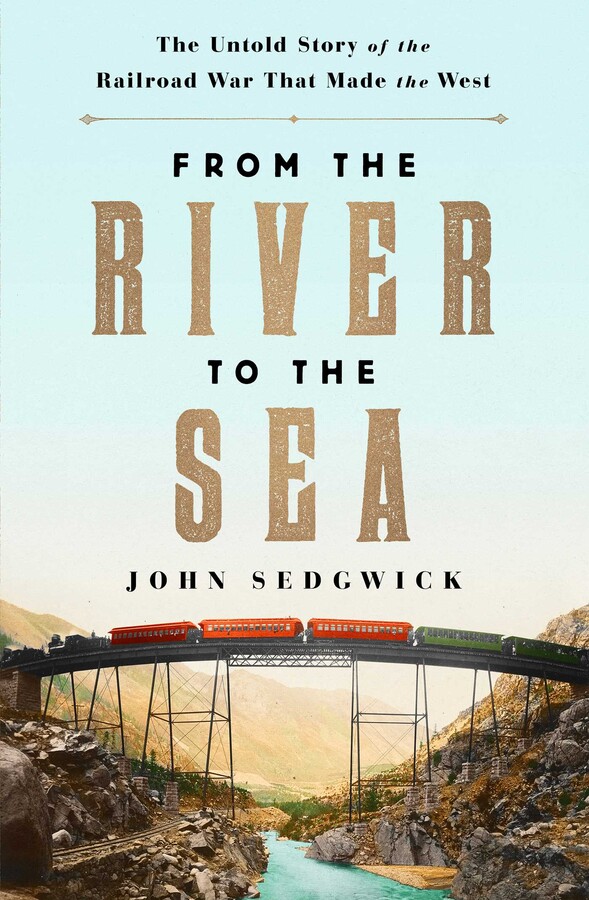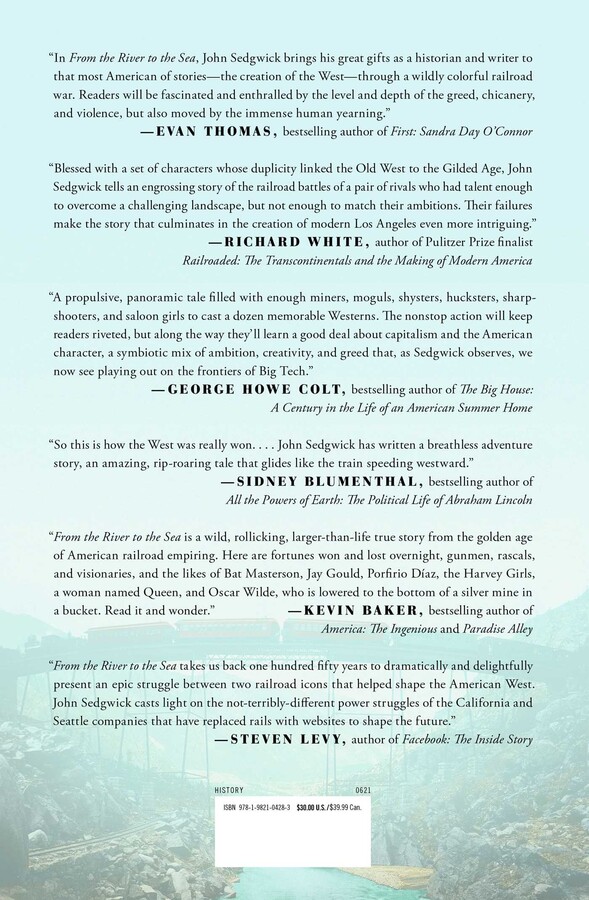Plus, receive recommendations and exclusive offers on all of your favorite books and authors from Simon & Schuster.
LIST PRICE $30.00
Free shipping when you spend $40. Terms apply.
Buy from Other Retailers
Table of Contents
About The Book
A propulsive and panoramic history of one of the most dramatic stories never told—the greatest railroad war of all time, fought by the daring leaders of the Santa Fe and the Rio Grande to seize, control, and create the American West.
It is difficult to imagine now, but for all its gorgeous scenery, the American West might have been barren tundra as far as most Americans knew well into the 19th century. While the West was advertised as a paradise on earth to citizens in the East and Midwest, many believed the journey too hazardous to be worthwhile—until 1869, when the first transcontinental railroad changed the face of transportation.
Railroad companies soon became the rulers of western expansion, choosing routes, creating brand-new railroad towns, and building up remote settlements like Santa Fe, Albuquerque, San Diego, and El Paso into proper cities. But thinning federal grants left the routes incomplete, an opportunity that two brash new railroad men, armed with private investments and determination to build an empire across the Southwest clear to the Pacific, soon seized, leading to the greatest railroad war in American history.
In From the River to the Sea, bestselling author John Sedgwick recounts, in vivid and thrilling detail, the decade-long fight between General William J. Palmer, the Civil War hero leading the “little family” of his Rio Grande, and William Barstow Strong, the hard-nosed manager of the corporate-minded Santa Fe. What begins as an accidental rivalry when the two lines cross in Colorado soon evolves into an all-out battle as each man tries to outdo the other—claiming exclusive routes through mountains, narrow passes, and the richest silver mines in the world; enlisting private armies to protect their land and lawyers to find loopholes; dispatching spies to gain information; and even using the power of the press and incurring the wrath of the God-like Robber Baron Jay Gould—to emerge victorious. By the end of the century, one man will fade into anonymity and disgrace. The other will achieve unparalleled success—and in the process, transform a sleepy backwater of thirty thousand called “Los Angeles” into a booming metropolis that will forever change the United States.
Filled with colorful characters and high drama, told at the speed of a locomotive, From the River to the Sea is an unforgettable piece of American history “that seems to demand a big-screen treatment” (The New Yorker).
Excerpt
L.A. THE ONLY CITY IN the world that goes just by its initials, like the self-assured global celebrity it is. Unlike Miami with its beaches, New York with its skyline, or Houston with its oil, Los Angeles is a fantasy of a city whose identity somehow floats free of mundane physical characteristics. All, that is, except for the sunshine radiating down from impossibly blue skies and the palm trees that rise up in greeting.
Unlike virtually everywhere else in America, to say nothing of America itself, L.A. has no founding myth to define it. No pilgrims, no explorers, no pioneers. While most people have the vague idea that the city dates back to Spanish times, the details are lost in the glitter, replaced by the gauzy notion that it somehow created itself as a product of its movie business.
It’s hard to account for it otherwise. Although L.A. lies by the sea, it did not begin life as a port. Nor was it birthed by the river that runs through it from the San Gabriel Mountains or a natural resource like the gold that brought prospectors surging into San Francisco. (Oil wasn’t found until L.A. was well established, which is why a pumpjack might be cranking away in a McDonald’s parking lot.)
No, the city in fact owes its origin to something so foreign to its self-conception that it represents a violation of its existential code. It was started by a railroad. Los Angeles is a railroad town. Startling as that might sound, on reflection it should not be quite so surprising, since railroads gave rise to countless cities in the West (and plenty in the East, too). While San Francisco, up the coast, was not built by a railroad, it was certainly built up by one when the first transcontinental arrived there in 1869. Numerous other western cities were created almost entirely by railroads—Denver, Reno, Dallas, Houston, Seattle, Tacoma, to name just a few.
Curiously, Los Angeles was not the result of the first railroad that came to town nearly so much as the second. Its arrival set off a furious competition between the two in the spring of 1887 that dropped the price of a $125 ticket from Chicago to just one single solitary dollar. The news set off a stampede into Los Angeles. Just in the first three years of the frenzy, it went from a sun-splashed Spanish pueblo of thirty thousand to a bustling city of a hundred and fifty thousand, a fivefold expansion that marks the most explosive growth of any city in the history of the United States. That growth curve has rarely flattened since.
Over a thousand miles to the east, Colorado Springs lies just south of Denver on the edge of the Rockies, a mile up in the crystalline mountain air. A rather sedate, if not sleepy, college town in the shadow of Pikes Peak, a jagged-topped “fourteener” that looms over everything, Colorado Springs was also created by a railroad. Founded in 1871, it was intended to be a mountain retreat in the Alpine manner, a place of healthy air and cultural refinement for high-end refugees brought in by train from the smoggy East. Small, out-of-the-way, closed-in, Colorado Springs seems to exist in a separate universe or on a separate plane of meaning from L.A. But there is a connection between them all the same.
The train that made the modern Los Angeles started in Colorado Springs. Not literally—the town never had an L.A. Express—but figuratively, riding the tracks of history, which often run by puzzling, circuitous routes from the past into the present. While the course of progress is often thought to be the result of economic, social, technological, and environmental forces beyond anyone’s control, that was not at all true of the development of the railroads. In the robust industrial age, they were all run by powerful, strong-minded men who bent their industry, and a good deal of the country, to their will. They set the course, chose the route, and built up the cities and towns their tracks reached. In this, Colorado Springs and Los Angeles were no exception.
The fates of these two distant cities, one as big as the other is small, were linked because the railroad men behind them were linked. More than linked, in fact. Bound like a pair of conjoined twins, two bodies somehow sharing a single mind, burning as one with the identical, all-consuming determination to go west. It was freakish, but undeniable: these two wildly different men became almost indistinguishable once they focused on the same objective and did so in the full realization that only one of them could attain it. It made quite a ball of fire, this frenzied competition, a blind, stupid, and utterly destructive jealous rage. A sun all of their own making that drew all eyes to it—even as the real one rose up overhead, day after day, and silently crossed the sky to the far horizon, as if to remind these two railroad men what they were fighting for: the chance to develop and define the modern West as no one else could.
Product Details
- Publisher: Avid Reader Press/Simon & Schuster (June 1, 2021)
- Length: 352 pages
- ISBN13: 9781982104283
Browse Related Books
Raves and Reviews
PRAISE FOR FROM THE RIVER TO THE SEA:
“A riveting account of the railroad wars of the nineteenth century, when the Atchison, Topeka, and Santa Fe battled the Denver and Rio Grande for control of the Raton Pass, New Mexico, Santa Fe (Lamy!), and the road to California and the sea. It’s a great read, full of colorful characters and outrageous confrontations back when the west was still wild.” —George R.R. Martin
"Sedgwick has produced a book perfectly suited, in its manageable length and rich incidental detail, for the return of mass air and rail travel. . . . The book has so many outlandish characters--tycoons who fall in love with women named Queenie and Baby Doe; murder among the Wall Street predators--that it seems to demand a big-screen treatment." —Adam Gopnik, The New Yorker
“In From the River to the Sea, John Sedgwick brings his great gifts as an historian and writer to that most American of stories, the creation of the West, through a wildly colorful railroad war involving a host of characters from Oscar Wilde to a vixen named Baby Doe. Readers will be fascinated and enthralled by the level and depth of the greed, chicanery and violence, but also moved by the immense human yearning.” —Evan Thomas, New York Times bestselling author of First: Sandra Day O’Connor
“Blessed with a set of characters whose duplicity linked the Old West to the Gilded Age, John Sedgwick tells an engrossing story of the railroad battles of a pair of rivals who had talent enough to overcome a challenging landscape, but not enough to match their ambitions. Their failures make the story that culminates in the creation of modern Los Angeles even more intriguing.” —Richard White, author of Pulitzer Prize finalist Railroaded: The Transcontinentals and the Making of Modern America
“So this is how the west was really won—a visionary Medal of Honor winning Civil War general wages the battles of the great railroad wars, crosses the great American desert with narrow gauge tracks, defeats his ruthless rival and a posse led by Bat Masterson, creates Colorado Springs, marries the woman of his dreams (of course named Queen), and pulls his Santa Fe railroad into Southern California to create a boom and the rise of the City of Los Angeles. John Sedgwick has written a breathless adventure story, an amazing rip-roaring tale, that glides like the train speeding westward.” —Sidney Blumenthal, bestselling author of All the Powers of Earth: The Political Life of Abraham Lincoln
“John Sedgwick’s account of the no-holds-barred race to build a railroad from the Mississippi to the Pacific is a propulsive, panoramic tale filled with enough miners, moguls, shysters, hucksters, sharpshooters, and saloon girls to cast a dozen memorable Westerns. The nonstop action will keep readers riveted, but along the way they’ll learn a good deal about capitalism and the American character, a symbiotic mix of ambition, creativity, and greed that, as Sedgwick observes, we now see playing out, for better and for worse, on the frontiers of Big Tech.” —George Howe Colt, bestselling author of The Game and The Big House
“From the River to the Sea is a wild, rollicking, larger-than-life true story from the golden age of American railroad empiring. Here are fortunes won and lost overnight, moguls and gunmen, rascals and visionaries, and the likes of Bat Masterson, Jay Gould, Porfirio Diaz, the Harvey Girls, a woman named Queen, and Oscar Wilde, lowered to the bottom of a silver mine in a bucket. Read it and wonder.” —Kevin Baker, bestselling author of America: The Ingenious and Paradise Alley
“From the River to the Sea takes us back 150 years to dramatically and delightfully present an epic struggle between two railroad icons that helped shape the American West. Sedgwick casts light on the not-terribly-different power struggles of the California and Seattle companies that have replaced rails with websites to shape the future.” —Steven Levy, author of Facebook: The Inside Story
Resources and Downloads
High Resolution Images
- Book Cover Image (jpg): From the River to the Sea Hardcover 9781982104283















